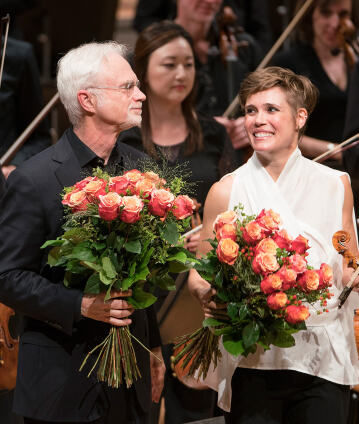John Adams conducts John Adams

John Adams is one of the best-known composers of minimal music – although on occasion he mixes it with a decidedly melodious, sometimes almost late-Romantic tonal language. In the 2016/17 season, Adams was the Berliner Philharmoniker’s Composer in Residence and made his debut conducting the orchestra in this concert. The programme included his famous Harmonielehre and the violin concerto Scheherazade.2 with soloist Leila Josefowicz.
“On a purely technical level,” John Adams says, “my works don’t seem to be as complicated as those by many other contemporary composers. My musical ideas have never required the complex forms that we normally expect these days from serious composers. The difficulties in my music are in the concentration and the energy. The music is very difficult to perform in this respect since you immediately notice when an instrumentalist is not playing the right notes. That is not the case for many contemporary pieces, where often only the composer notices if something is not right …” John Adams, Philharmonic Composer in Residence in the 2016/17 season, is one of the main representatives of American minimalism – a musical style where simple basic patterns are repeated over longer periods of time with only slight changes that can sometimes barely be perceived. However, Adams distanced himself early on from the rigid mechanics of the first minimal compositions: “My music is, I believe, more expressive. Jazzy, slow, fast, loud, soft – all those differences are important to me.”
The composer programmed his own Harmonielehre for his conducting debut with the Berliner Philharmoniker. The work was inspired by a dream in which an oil tanker in the San Francisco Bay took off into the sky like a rocket; this image has its immediate musical equivalent at the beginning of the work, where repeated E minor chords go off like cannon salvos. After the interval, the programme continues with the violin concerto Scheherazade.2, which John Adams composed “into the bow” of the violinist Leila Josefowicz. The piece was inspired by an exhibition at the Institut du Monde Arabe in Paris, which was centred around the stories from the Thousand and One Nights, particularly the Scheherazade figure: “The casual brutality towards women,” says Adams, “that lies at the base of many of these tales prodded me to think about the many images […] that we see today in the news on a daily basis. I was suddenly struck by the idea of a ‘dramatic symphony’ in which the principal character role is taken by the solo violin.” Although the music does not tell a specific story, in his sound vision Adams follows a set of “provocative images” that are targeted against violence and oppression: scenes in which Scheherazade is pursued by religious zealots and put on trial before finally finding her freedom in the finale.
© 2016 Berlin Phil Media GmbH
Related interviews